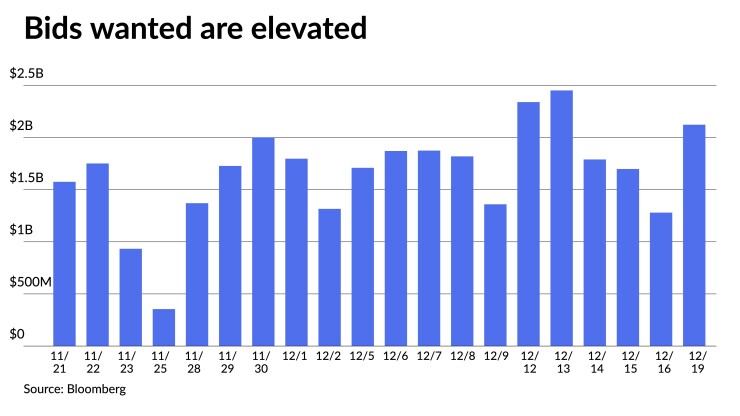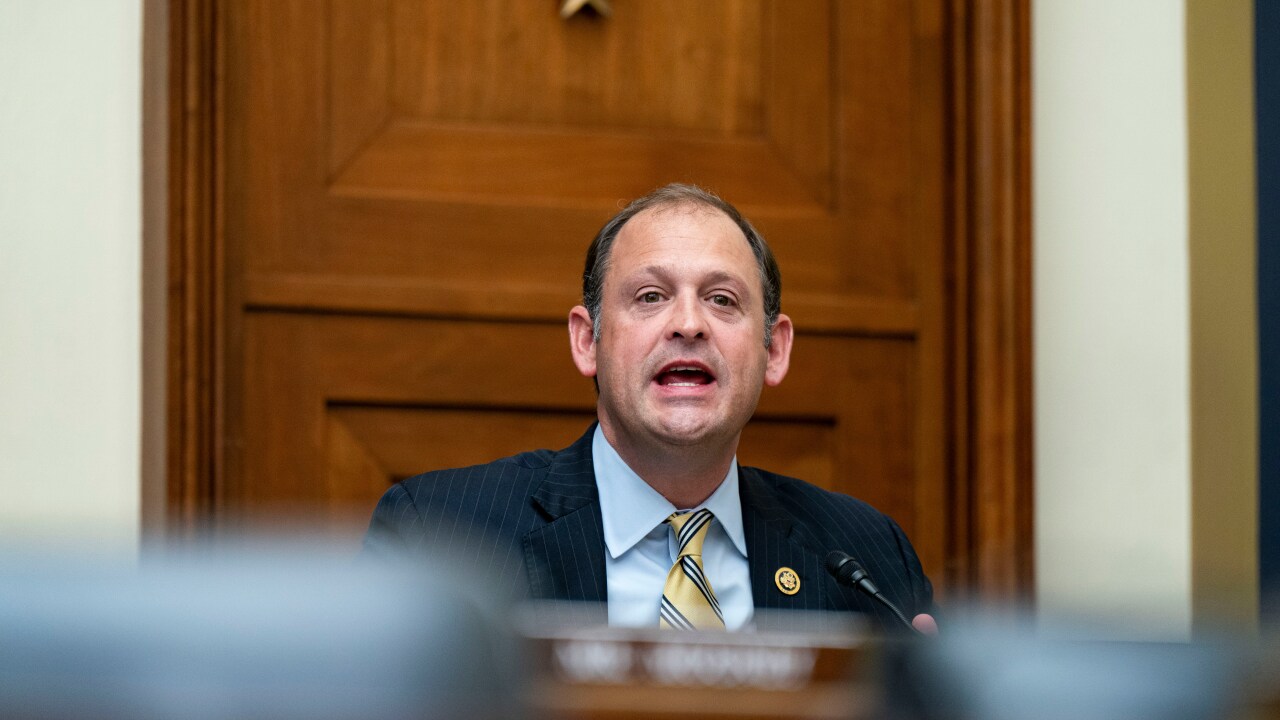Municipals were weaker across the curve Tuesday with the short end being hit the hardest, causing the muni curve to invert further. U.S. Treasuries extended their selloff out long and equities reversed losses to close out in the black.
Triple-A municipal yields rose up to 10 basis points on the one year, depending on the curve, while USTs saw yields rise up to 10 on the 30-year.
Muni-UST ratios were little changed Tuesday but short ratios are still rich. The three-year muni-UST ratio was at 61%, the five-year at 66%, the 10-year at 69% and the 30-year at 94%, according to Refinitiv MMD's 3 p.m. read. ICE Data Services had the three at 64%, the five at 67%, the 10 at 73% and the 30 at 96% at a 4 p.m. read.

Secondary selling pressure was concentrated most heavily on the one-year Tuesday, but sellers pushed yields higher across the curve by five to seven. Bids wanteds were on the rise again with Monday's total hitting $2.122 billion.
And while overall municipal bond yields fell slightly last week, the
The short-end correction continued Tuesday and ultra short funds are seeing large losses.
While the two-year UST ended the week 17 basis points lower, tax-exempt benchmark 2-year spots finished 10 to 12 basis points higher, "inverting tax-exempt curves' 2s/5s term spreads and the offered side's 2s/10s for the first time in decades," Fabian said.
"The SIFMA 7-day index adjusted for both this Fed hike and the last one, resetting 152bps higher to 3.73%: 86% of SOFR," he noted.
SIFMA's prior outperformance had "bled 2a7 assets; tax-exempt money funds had lost nearly $10.0B in assets in the prior [four] weeks," Fabian said. This was the largest four-week loss since the $11.3 billion outflow in March 2020.
Some of that had flowed to dealer balance sheets, whose variable-rate demand obligation holdings rose to $5.7 billion on Dec. 7, some likely into the SUB and other exchanged-traded funds, he said. SUB has added +$1 billion in the same four weeks.
"Curve inversions happen only rarely in tax-exempt AAA benchmarks, and when they do they have resolved quickly; in 2022/2023, this would seem to argue for a front-end rally, which would be in keeping with UST's movement last week," Fabian said.
And moves like this, he said, "are more possible in weeks like this one, where new-issue supply, trading liquidity, and investor interest are apt to keep sinking into [Dec. 31]; thin trading flows permit larger price movements, all else equal."
The rest of the curve appears stable, and relative value ratios are settling just below rolling averages at the five- to 30-year spots, he noted.
He said, "valuation has also been resilient, reading as overbought on the first half of the curve, oversold longer."
Nuveen's Anders S. Persson and John V. Miller said municipals are closing out the year with a solid tone.
After the Wednesday Fed meeting, "Chair Powell reiterated that the Fed has more work to do to bring inflation down to its target of 2%," Nuveen strategists said in a weekly report.
"This may mean more rate increases in 2023 than previously expected. Investors remain divided into two camps," they said. "One thinks the Fed is essentially done raising rates as inflation is declining. The other believes the Fed should continue raising rates since inflation remains at about 7%."
"Rates are substantially higher than the beginning of the year, attracting new investors," they noted. Additionally, "managers continue to execute tax swaps through year end," they noted.
"Munis should begin 2023 with a good tone, as there will be billions of dollars to reinvest with a sparse new-issue calendar," they said.
The high-yield muni market is returning to more solid footing, they said.
"Last week, the Pennsylvania Department of Transportation issued a $1.8 billion deal, the largest of the year, which was heavily oversubscribed," they said.
New issuance, Nuveen strategists noted, "should be negligible for the remainder of the year. Net outflows were modest last week due to latent tax loss selling."
Bond Buyer 30-day visible supply sits at $7.38 billion while Bloomberg data shows net negative supply at $9.788 billion.
The market was bolstered by Dec. 15 reinvestment cash flows and will be supported even more by January cash flows.
"In a sign that liquidity continues to strengthen, high-yield muni exchange-traded funds are receiving heavy inflows and becoming a larger market presence in the market," they said.
In the competitive market Tuesday, the Albuquerque Metropolitan Arroyo Flood Control Authority, New Mexico, (Aaa///) sold $12.500 million of general obligation bonds, Series 2023A, to Fidelity Capital Markets, with 5s of 2023 at 2.81%, 5s of 2027 at 2.51%, 4s of 2032 at 2.68% and 4s of 2033 at 2.73%, callable 8/1/2030.
Secondary trading
Washington 5s of 2023 at 2.94%. Maryland 5s of 2024 at 2.74%. California 5s of 2024 at 2.60%. Montgomery County, Maryland, 5s of 2024 at 2.57%.
Maryland 5s of 2026 at 2.48%. Ohio 5s of 2028 at 2.52%.
Los Angeles Department of Water and Power 5s of 2029 at 2.45%-2.44%. University of North Carolina Chapel Hill 5s of 2031 at 2.57%.
New York Dorm PITs 5s of 2033 at 2.79%-2.78%. Columbus, Ohio, 5s of 2034 at 2.84%. Boston 5s of 2035 at 2.83%-2.82%. District of Columbia income tax 5s of 2036 at 3.16%-3.15%.
New York MTA 5s of 2044 at 3.94%.
AAA scales
Refinitiv MMD's scale was cut five to 10 basis points: the one-year at 2.76% (+10) and 2.54% (+5) in two years. The five-year at 2.48% (+5), the 10-year at 2.54% (+7) and the 30-year at 3.49% (+7).
The ICE AAA yield curve was cut five to seven basis points: 2.73% (+7) in 2023 and 2.59% (+5) in 2024. The five-year at 2.53% (+6), the 10-year was at 2.60% (+6) and the 30-year yield was at 3.50% (+5) at 4 p.m.
The IHS Markit municipal curve was cut 10 on the short end: 2.74% (+10) in 2023 and 2.55% (+6) in 2024. The five-year was at 2.51% (+6), the 10-year was at 2.55% (+6) and the 30-year yield was at 3.47% (+6) at a 4 p.m. read.
Bloomberg BVAL was cut five to seven basis points: 2.69% (+7) in 2023 and 2.57% (+6) in 2024. The five-year at 2.49% (+5), the 10-year at 2.57% (+5) and the 30-year at 3.49% (+6) at 4 p.m.
Treasuries were weaker.
The two-year UST was yielding 4.261% (flat), the three-year was at 4.021% (+2), the five-year at 3.788% (+7), the seven-year 3.773% (+9), the 10-year yielding 3.683% (+9), the 20-year at 3.931% (+10) and the 30-year Treasury was yielding 3.736% (+10) at the close.





